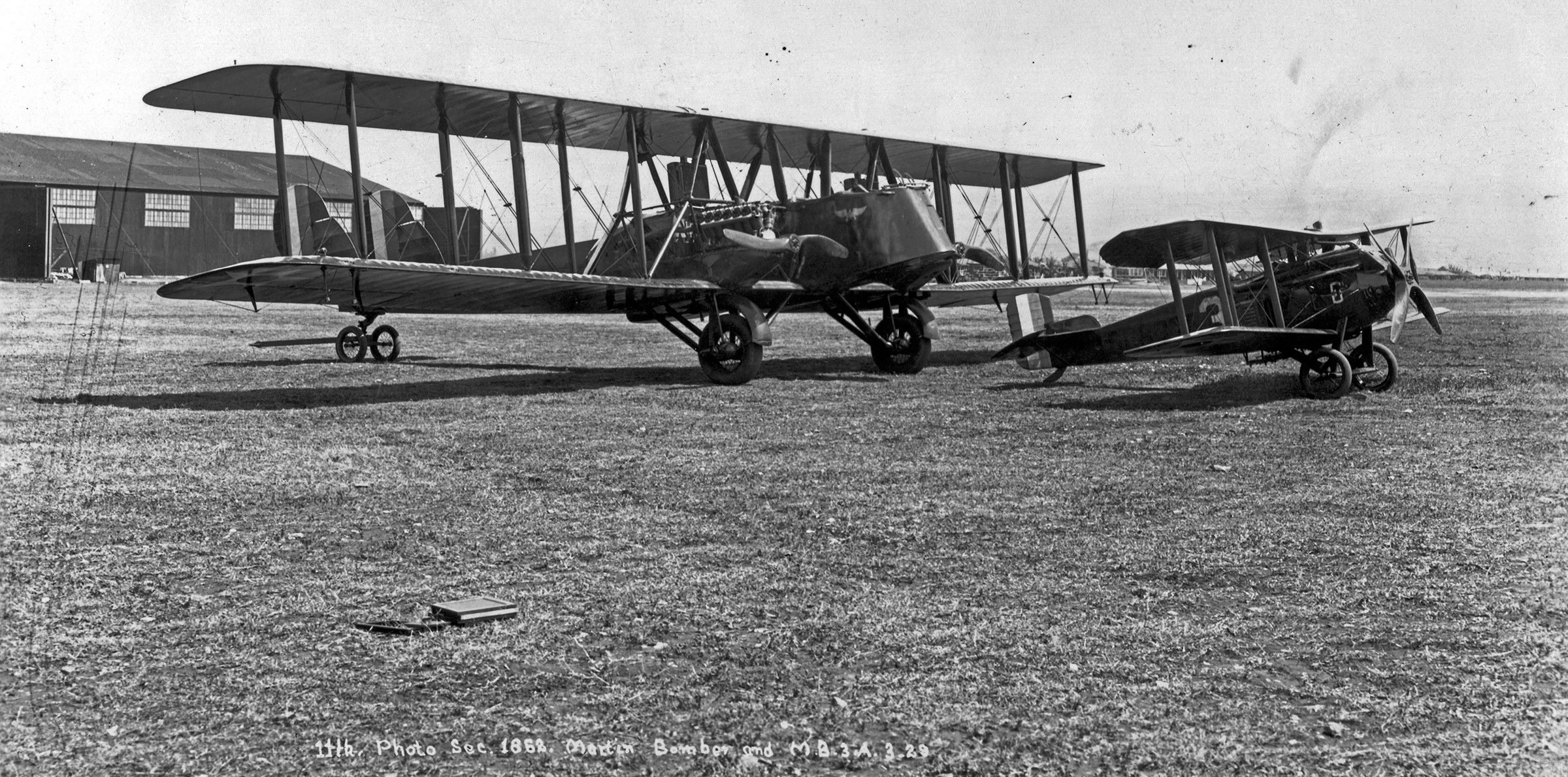Posted on February 18, 2016
By Burl Burlingame | [email protected] | Pearl Harbor Aviation Museum
It’s a photograph of a day like any other in Hawaii, a half-century ago. A wood and wire Army bomber rumbles through the azure sky, criss-crossing the pellucid air above Oahu on an obscure military mission. But wait a minute — take a closer look. What’s that guy doing hanging on the landing gear?
June 23, 1927, and newspapers were filled with hot-dog pilots possessing whatever the stuff is that later would be called “right.” Pictures of Lucky Lindy whooping it up in Paris; a half dozen attempts being planned to fly non-stop to Hawaii from the Mainland; Commander Richard E. Byrd touring the world after soaring over the North Pole. In Nicaragua, US Marines in biplanes were flying bombing missions against Sandinista rebels.
Things have changed since those barnstorming days of wind humming in the wires and silk scarves snapping in the slipstream. The air is no longer a frontier, but it was once.
The plane is a twin-engine Martin bomber, the NBS-1, made out of wood and steel pipe and covered with varnished linen. It was held together by wires with turnbuckles — if the wings sag, tighten the turnbuckles.
It was stationed with the 23rd Bombardment Squadron on Ford Island, at what was then called Luke Field. The little strip was named after Frank Luke, a wildfire World War I ace with a go-to-hell grin who died in action before he could be court-martialed for insubordination. Instead, he was given a Medal of Honor.
At about 8 in the morning that June 23, five Martins took off from Luke Field. Their mission was to drop practice bombs on Oahu’s North Shore in conjunction with Army maneuvers going on in the same area. The pilot of the plane in the photograph was Lt. George W. Polk. Sgt. Philip Monroy was the crew chief, and privates Raymond L. Cyr and Harold L. Valentine were the crew members. For recruits Cyr and Valentine, it was their first flight.
Immediately after takeoff, Polk learned his landing gear was damaged. Four bolts connecting one of the gear struts to the right wheel had popped like brittle chicken bones. The wheel dangled loosely, twisting in the wind.
Aircraft in those days usually didn’t have radios. Polk circled the field and tossed out a note requesting that four new bolts and some rope somehow be sent up. The Martin then veered off for the North Shore to finish its mission.
A DeHavilland DH-4, a two-man aircraft dating back to the Great War, took off from Luke piloted by Lt. J.D. Givens, with Lt. Phillip Schneeberger in the back seat holding onto the package of bolts and rope. They bumped into a bomber formation and jockeyed for position in the rough air above the formation.
Schneeberger tied the package to a line and tossed it over the side of the DeHavilland, lowering it like a yo-yo into one of the bombers sliding around below. The bomber crew lunged wildly for the package as it danced in the slipstream.
They finally snared the package, opened it and scratched their heads.
It was the wrong ship.
The bomber crew waved at the DeHavilland and got Schneeberger to lower his line again. The package was reattached, but on the way back up, the fastening snapped and it plummeted into the cane fields. Givens dashed back to Luke Field, landed and put together another package of repair gear. He also got a more complete description of the crippled Martin and took off again.
While all this was happening Polk had completed his practice mission with the rest of the bomber formation. On the way back to Pearl Harbor, Givens’ DeHavilland and Polk’s Martin found each other and Schneeberger once again reeled out his package of bolts and rope.
Valentine in the front cockpit and Cyr in the rear cockpit grabbed for the bobbing package as it rambled around the bomber. They kept missing; neither recruit was used to the split-second timing needed to snare things in mid-air.
Schneeberger, 40 years old and a PhD. from Johns Hopkins, realized that the situation required desperate measures. He pulled up the package, tucked it under his arm and climbed out of the DeHavilland cockpit onto the wing. The blast of the slipstream bullied him as he clung to struts and bracing wires with his free hand and carefully worked his way to the wingtip.
He wished he hadn’t worn shoes with slippery soles.
Monroy, the bomber’s crew chief, did the same thing, creeping out on the adjacent wing of his ship. Monroy and Schneeberger each wrapped an arm around a strut and dangled off the wingtips, reaching out with their free hands. The two aircraft were thrown off balance by the men on the wings and slewed unsteadily through the air. Pilots Givens and Polk gradually maneuvered their ships until the wings almost touched.
As the tips see-sawed up and down in the buffeting wind, Monroy grabbed for the package and got it after several wild swings. Holding it tightly he made his way back to the Martin’s fuselage.
Schneeberger, returning to his seat, was climbing back inside when his parachute suddenly popped open. He scrambled desperately on the fuselage as the ‘chute burst open in a blossom of silk and hard air, almost yanking him off the biplane. Schneeberger slammed the release catch and the harness ripped away. He tumbled headlong into the cockpit.
The parachute flew back and fouled the tail control surfaces. The DeHavilland swung out of control for a moment before Givens slipped the plane sideway through the air. The chute fell free of the tail.
Givens and Schneeberger landed at Luke Field without further incident — or accident.
Things were still buzzing above them. Polk, searching for calm air, flew the Martin at altitudes varying from 1,000 to 8,000 feet. He was finally able to keep the slipstream down to a face-tearing 90 miles per hour.
Monroy crawled down onto the broken landing gear, where he discovered there was no room to work while wearing a parachute. It was at this moment the photograph was taken by an observer in another aircraft. It was 10:45 a.m.
Monroy climbed back into the Martin and shrugged off his ’chute. Private Cyr was told to also remove his parachute and join Monroy out on the wing. His thoughts on this are not recorded.
Monroy settled into the niche between the wheel and wheel strut and tried to replace the shattered bolts. Cyr, clinging to the wing above, handed tools to Monroy.
It was useless. Unable to get any leverage behind the heavy wheel, the two weren’t able to line up the bolt holes. Polk rocked the aircraft, but that didn’t help either and almost tossed Monroy off the wheel strut.
They gave up at noon and climbed back aboard.
Ford Island, Pearl Harbor

Polk decided to pancake the big plane in the water next to Ford Island. A few months before he had done the same thing in a smaller aircraft, when an engine had sputtered out too far from land to glide in safely. Damage had been minor and the plane was fished out of the water and repaired. Polk figured he could do it again.
He turned the Martin over Ford Island, booming across Luke Field to toss the parachutes out so they wouldn’t be damaged by salt water. Valentine, in the nose of the plane, heaved his parachute over the left side. It flipped straight back and thudded into the engine propeller.
The chute shredded and stalled the engine. The propeller stopped hot-iron cold, streamers of silk flying back from the blades. The Martin shuddered and jerked to the left as the right-hand engine took on the load of pulling it through the air.
Pearl Harbor

Polk was in a tough spot. He was too low and losing more feet every second. A 30-mile wind was blowing from his tail, adding to his speed rather than reducing it. Below was a narrow strip of water, ahead a jutting peninsula covered with trees that would have gutted the bomber like a fish filet. He pointed the nose down.
The bomber slammed straight into Pearl Harbor with terrific impact and snapped over. The crew were head down, stunned and under water. Army and Navy boats were on them in seconds. Sailors pulled the crew out and deposited them on Ford Island, where they walked back to Luke Field in their soaking flight suits. None were injured.
Reporters showed up that afternoon and Lt. Polk regaled them with the story of the flight. He commented that having been dunked twice, he now seemed fairly well qualified for submarine service.
Sgt. Monroy didn’t show up for the press and was tracked down in the 23rd Squadron hangar, working on another aircraft. He didn’t consider the events of the morning to be all that unusual.
It was, he said, all in a day’s work.


